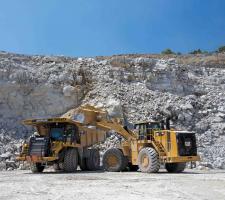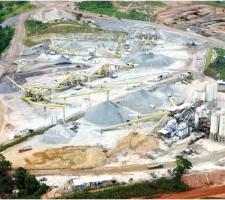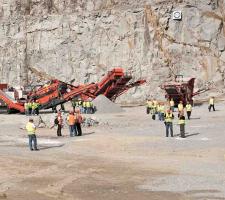
A generally positive outlook for construction aggregates demand in Latin America should bode well for this industry. In fact, the aggregates sector has the potential to become one of the region’s key engines of growth in the next decade. It is time for resource-rich Latin America to work towards developing this sector fully, writes Adriana Potts.
The past five years or so have seen the Latin American aggregates market grow – at a slower pace than in other geographical regions, granted, but aggregates suppliers have certainly benefited from regional construction spending. Increasing demand for commercial, retail, and industrial properties has greatly boosted building construction and related product sales. Government investment in public infrastructure has stimulated construction spending and generated a considerable product demand.
In Brazil, for instance, the aggregates sector has been boosted by the boom experienced in the construction sector, especially in housing and a large number of infrastructure projects undertaken as part of the preparations for the 2014 World Cup and 2016 Olympic Games. The aggregates market in Brazil has also strongly benefited from regional economic growth driven by mineral exports to large consuming markets such as China.
Promising land?
Latin America’s largest aggregate market is Brazil, which accounts for nearly one half of the area’s product sales. Other countries with sizeable aggregates markets are Mexico, Argentina, Colombia, Chile, Peru and Venezuela. However, aggregates use in the region is quite low by global standards because many of the region’s countries have undersized economies, small construction sectors and underdeveloped public infrastructures. On the other hand, there are hundreds, if not thousands of quarries in the region and because of Latin America’s need for more and better transport and other infrastructure, the potential for growth over the next decades will remain positive, despite recent economic challenges.
According to US-based international market research firm The
Freedonia forecasts that sales of construction aggregates in Central and South America are to increase by 5.3% per annum to 2.2 billion tonnes in 2017, somewhat slower than the average global pace. Meanwhile in Mexico, demand for construction aggregates is projected to rise 4.7% per annum through 2017 to 605 million tonnes. The research firm says that solid construction spending gains will boost growth in the aggregates market and advances in residential building construction spending are expected to accelerate significantly through 2017, generating high product demand.
An interesting forecast by Freedonia is the region’s steady move to alternative, secondary and recycled aggregates; not only because reserves of natural aggregates are, in some areas, becoming exhausted but also because of their lower price and lower transportation costs.
Meet the producers
A large number of construction aggregates companies are based in Latin America. Brazilian
Another local giant is Mexican
Other notable suppliers based in the region are Delta Arenas Industriales of Argentina; Andreetta, Embu, and Grupo Estrutural of Brazil; Ideal Dominicana of the Dominican Republic; and Corzel S De RL of Honduras. In Mexico, as well as CEMEX, there is GMC Mugo and Ladrillera Santa Clara.
Many foreign multinationals operate aggregates production facilities in Latin America and are among the local industry leaders. These include
Recently-formed LafargeHolcim (born out of last year’s merger between France’s Lafarge and Switzerland’s
LafargeHolcim says it has extensive experience of operating in emerging markets that have favourable growth prospects but at the same time can be more volatile than, for instance, the mature markets of Europe or the US. “While different markets present different challenges, this also offers us opportunities to differentiate ourselves and create value based on our strong commitment to these countries,” says Pascal Casanova, member of the Executive Committee of LafargeHolcim responsible for Latin America.
One company that benefited from the Lafarge Holcim merger is Irish building materials group CRH, which in August last year acquired a global portfolio of assets from the larger companies which were rationalising their portfolios. The deal doubled CRH’s cement volume and expanded its cement, aggregates and ready-mix concrete portfolio. According to CRH, the deal makes it the third largest building materials company in the world and the second largest in terms of aggregates production.
The company’s operations in Latin America fall under its CRH Americas division and comprise operations in Brazil, Argentina and Chile. Mark Towe, currently president & chief executive of Oldcastle and also an executive director of the board, assumed the new role of chairman, CRH Americas on 1 Jan 2016.
Equipment Manufacturers
A great deal of equipment, both crushing and screening, and loading and hauling, is in operation throughout the region working in quarries, aggregate plants, concrete and cement facilities as well as general construction applications.
Due to the large geographic distances involved and with many operations located in remote areas, customer support and aftermarket care are essential. This means that manufacturers have had to develop a good local presence, mainly through dealer networks.
Such is the case of leading equipment suppliers
With a strong presence in Brazil (its largest market), Argentina, Colombia, Peru and Chile, this is a key region for Sandvik Mining & Rock Technology. The company’s infrastructure to support its customers comprises direct sales and support, dealers and distributors as well as country-based operations. The rest of the region is being covered by an extensive dealer network and, in fact, the company is currently actively recruiting dealers and distributors.
According to Sandvik, at present all markets can be said to be volatile to a greater or lesser extent and Latin America is no different. Edison Rocha, former Vice President Construction for Sandvik in South America, says: “Many of the adverse economic factors that have a negative effect in some market areas have not affected Sandvik so much due to our strong market presence. In fact the opposite could be said to be true, with our equipment being in demand to support government investment in infrastructure projects.”
Latin America is one of the most important geographical regions for
“This enabled us to establish a strong market presence and to develop technology with several important customers,” says Marcelo Motti, senior vice-president – Brazil. Mr Motti, who is also responsible for the Minerals, Services and Flow Control segments of Metso Brazil, says that during those first years, they developed a robust service structure, including foundry facilities and service centres in order to provide a competitive product and qualified maintenance expertise to their customers. “Through challenging times we have been able to keep our businesses and customers operating successfully due to this well-structured organisation. Additionally, we have invested heavily in automation and have several examples of completely automated crushing plants.”
Some of the latest aggregates projects in the region where Metso has been involved include the Belo Monte hydroelectric plant in Brazil; the Tuy II dam in Venezuela; and the Embú and Ludice quarry crushing and screening plant installation projects in Brazil.
Despite the recent economic challenges, Mr Motti remains upbeat about the region: “We’ll continue to develop our business here with new technology, more safety and focus on our customers’ needs. There is a strong trend for plant automation and monitoring and we are ready to support our customers towards technology development.”
A relatively recent arrival in the region is German crushing and screening plant manufacturer
Kleemann began sales operations in Latin America in 2011. “Prior to that, we worked on building a dealer network and after-sales support structure so we could provide the market with a complete solution,” says Luiz Zoch, General Manager, Latin America Division.
Kleeman currently has a presence in all of Latin America, including Central America and the Caribbean islands. According to Mr Zoch, the company’s market share is measured by product line, such as jaw and impact crushers and screens. “In 2014 we reached a 21% market share in Latin America, which represents an important achievement considering we’ve only been in the region for about five years.” Mr Zoch adds that in some specific countries Kleeman actually achieved a major market share: 90% in Bolivia, 78% in Colombia, 62% in the Dominican Republic, 40% in Mexico, 37% in Brazil, 32% in Argentina and 25% in Chile.
Kleeman is active in two main areas: mining/quarrying and contractor. According to the company, the contractor sector is connected to the road business sector and is affected by governmental political and economic strategies. “This segment suffered a sharp reduction during 2015, especially in South America as a consequence of the Brazilian political instability and also by the devaluation of Latin America currencies against the US dollar,” explains Mr Zoch.
However, mining/quarrying is connected mostly to the private market and, according to Kleeman, it continues to grow steadily. “Mining is an important sector in many Latin American countries, not only for mineral exports but also for the supply of aggregates to the infrastructure industry and raw materials to the cement industry. This, in turn, serves the powerful industry of civil construction, one of the mainsprings of economic growth in most Latin American countries.”
According to Mr Zoch, the mining sector’s broad performance creates a natural shield for the volatility of the Latin American markets: “We intend to continue increasing our participation focused on the mining/quarry segment as the flagship of our strategy.”
When it comes to loading and hauling material in aggregate operations
“Over the years, we have forged long-term relationships with our Latin American customers. It enables us to deeply understand the quarry and aggregates industry needs and develop customised products & dedicated solutions like fleet dimensioning, site assessments, fleet management and job site solutions,” says Ricardo Souza, product marketing specialist, Load & Haul, South America.
Amongst Caterpillar’s new products for this sector are the Cat 986H wheeled loader (12.7tonnes for loose material and 10tonnes in the quarry face); the Cat 988K wheeled loader (14.5tonnes for loose material and 11.3tonnes in the quarry face) as well as the new articulated trucks Cat 735C, 740C EJ (Ejector) and 745C, which all have new features when compared to B-Series trucks.
Another leading manufacturer providing solutions for quarries and aggregates in Latin America is Volvo Construction Equipment, which has been present in the region for over 50 years. “The quarries and aggregates sector, along with heavy construction and mining, is one of the top segments for
Mr Chueire agrees that Brazil is the largest construction equipment market in Latin America and also the most relevant when it comes to the aggregates sector. “About 10% of Volvo CE sales in Brazil are for quarries and aggregates customers and they are either large companies holding a significant fleet or small family businesses, sometimes owner-operators. Our crawler excavators and wheeled loaders are the most sought-after equipment by customers in this segment.”
For Mr Chueire, the scenario ahead is definitely challenging for the aggregates sector, “The way out of the crisis for Brazil is to increase investments in infrastructure; this will support the demand at good levels for quarries and aggregates.”
Central & South America Construction Aggregates Demand (Million tonnes)
| Item | 2012 | 2017 | 2022 |
|---|---|---|---|
| Construction Aggregates Demand | 1700 | 2200 | 2750 |
| Crushed Stone | 625 | 835 | 1080 |
| Sand | 735 | 925 | 1115 |
| Gravel | 245 | 310 | 380 |
| Other Types | 95 | 130 | 175 |
Mexico Construction Aggregates Demand (Million tonnes)
| Item | 2012 | 2017 | 2022 |
|---|---|---|---|
| Construction Aggregates Demand | 480 | 605 | 745 |
| Crushed Stone | 132 | 175 | 230 |
| Sand | 175 | 215 | 255 |
| Gravel | 143 | 175 | 210 |
| Other Types | 30 | 40 | 50 |
Source: The Freedonia Group, Inc.












